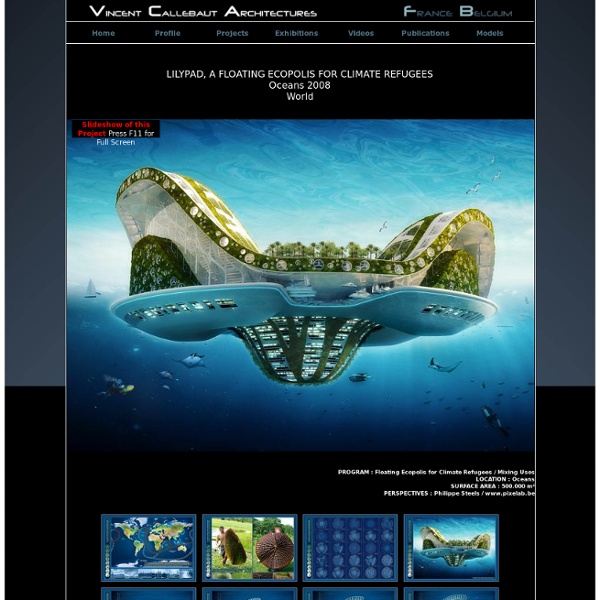Perspective Monde
GREEN FLOAT/Shimizu's Dream - Shimizu Corporation
Going Beyond CO2 Reduction to Carbon Negative To create a city that absorbs CO2 like a plant, we will employ environmental technologies to achieve a carbon negative system. Switch to a Compact City and Conversion of Industrial Structure (CO2 Reduction: About 40%) Reduce CO2 through more efficient transportation and distribution resulting from the shift to a compact city. Energy Conservation (CO2 Reduction: About 30%) At 1,000m above the equator, the temperature is around a comfortable 26°C. Power Generation Using Natural Energy (CO2 Reduction: About 30%) We will fully employ a range of natural energy sources including space solar power satellites, ocean thermal energy conversion, waves, wind and solar power. CO2 Recovery and Ocean Sequestration (CO2 Reduction: About 30%) The CO2 absorption capacity of the ocean is thought to be orders of magnitude greater than terrestrial forests. A Bustling Botanical City Where People Live in a Harmonious Balance with Nature Disaster and Evacuation Measures
Bionic-Arch is a Futuristic Green Skyscraper for Taichung / Vincent Callebaut
For the hundredth birthday of the creation of “Taiwan R.O.C.”, the main aim of the Taichung City Government is to honour the local building traditions and symbolize the new Taiwan dynamics into economic, political, social and cultural achievements. International model of the green building of the 21st century, the innovative and pioneering design of the Bionic Arch by Vincent Callebaut Architecture is part of the new master plan “Taichung Gateway – Active Gateway City”, the future urban oasis for lifestyle, innovation, culture and biodiversity in the heart of Central Taiwan. The green tower combines and surpasses the nine major indicators defining a green building by law, and intensifies the relation between the building site and the surrounding Taichung Gateway Park, including an environmental integration of the park and the green land, the integration of green vertical platforms, sky gardens and living façades, interaction between human and natural environments.
Dossiers documentaires Géographie
Wetropolis | S+PBA
According to the head of Thailand’s National Disaster Warning Center, Meteorologist Smith Dharmasaroja, by 2030 much of Bangkok will lie under 1.5 meters (5 feet) of seawater. With the city sinking 10 cm below sea level, the latter rising by 40 cm annually, the safest place to create architecture is above water. Thus, a Bangkok-based architecture firm S+PBA recently unveiled drawings for a self-sustaining community that can thrive with the ebb and flow of rising tides. Courtesy of S+PBA The project examines the entirely supra-marine stilt home community of Koh Pan Yii, a settlement that floats on the Andaman sea in Southern Thailand, successfully sustaining all of the typical functions of an urban community—schools, public spaces, hospitals, utilities, industry.
Règles pour le parc humain
Un article de Wikipédia, l'encyclopédie libre. Règles pour le parc humain, sous-titré Une lettre en réponse à la Lettre sur l'Humanisme de Heidegger, est un court essai philosophique écrit par Peter Sloterdijk, paru en 2000. Il déclencha une vive polémique outre-Rhin, celle-ci se poursuivant en France une fois l'ouvrage traduit. Il est traduit en français par Olivier Mannoni, aux Éditions Mille et Une nuits. Contenu[modifier | modifier le code] Les livres, courrier de l'humanisme[modifier | modifier le code] La lecture du courrier humaniste rendue marginale à la fin du XXe[modifier | modifier le code] Le rôle inhibiteur de la lecture, en opposition aux arènes et aux mass-médias[modifier | modifier le code] Heidegger et la clairière de l'Être[modifier | modifier le code] Les étapes du « dressage » de l'homme par lui-même[modifier | modifier le code] L'éleveur, maître de l'art pastoral[modifier | modifier le code] Règles pour le parc humain : la polémique[modifier | modifier le code]
Colloque "Vulnérabilité des écosystèmes côtiers au changement global et aux évènements extrêmes"
Biarritz, France, du 18 octobre 2011 au 21 octobre 2011 Vulnérabilité des écosystèmes côtiers au changement global et aux événements extrêmes - Croisement des disciplines et des savoirs pour assurer les services rendus par les écosystèmes côtiers et marins D’après le Millemium Ecosystem Assessment, on estime que 60% des écosystèmes côtiers dans le monde sont dégradés. Pourtant, ce sont des espaces de forte biodiversité et d’intense productivité. Les zones côtières représentent 75% de la production de l’océan pour 5% seulement de sa surface. La plupart supporte de nombreuses activités économiques et nombre d’entre eux produisent de nombreux services écosystémiques. Espaces fragiles, ils subissent de nombreuses pressions : influence des activités implantées dans les bassins versants ; densités humaines élevées ; conflits d’usage pour l’utilisation de l’espace ou l’utilisation des ressources. Trouver des solutions pour la préservation de ces espaces devient alors un enjeu majeur.
Fulcanelli et Julien Champagne
Fulcanelli l'alchimiste Julien Champagne, l'illustrateur de ses livres (23 janvier 1877 - 26 août 1932) Photo (lien vers le bas de page) du laboratoire de Julien Champagne, illustrateur des Fulcanelli. La bordure entourant cette photo porte en bas à droite une dédicace de J. Champagne à son maître Pierre Dujols (document inédit). Partons de choses sûres et connues : deux ouvrages d'alchimie portent comme nom d'auteur le pseudonyme "Fulcanelli". Le premier livre de Fulcanelli s'intitule "Le Mystère des Cathédrales et l'interprétation ésotérique des symboles hermétiques du Grand-oeuvre" et le second "Les Demeures Philosophales et le Symbolisme hermétique dans ses rapports avec l'art sacré et l'ésotérisme du Grand-Oeuvre". Ces deux ouvrages sont montés dans le domaine public, la publication ayant eu lieu il y a plus de soixante-dix ans et l'auteur étant anonyme. Etudions tout d'abord le dépot légal à la Bibliothèque Nationale de France : Auteur : Fulcanelli (pseudonyme de Jean Julien Champagne)



